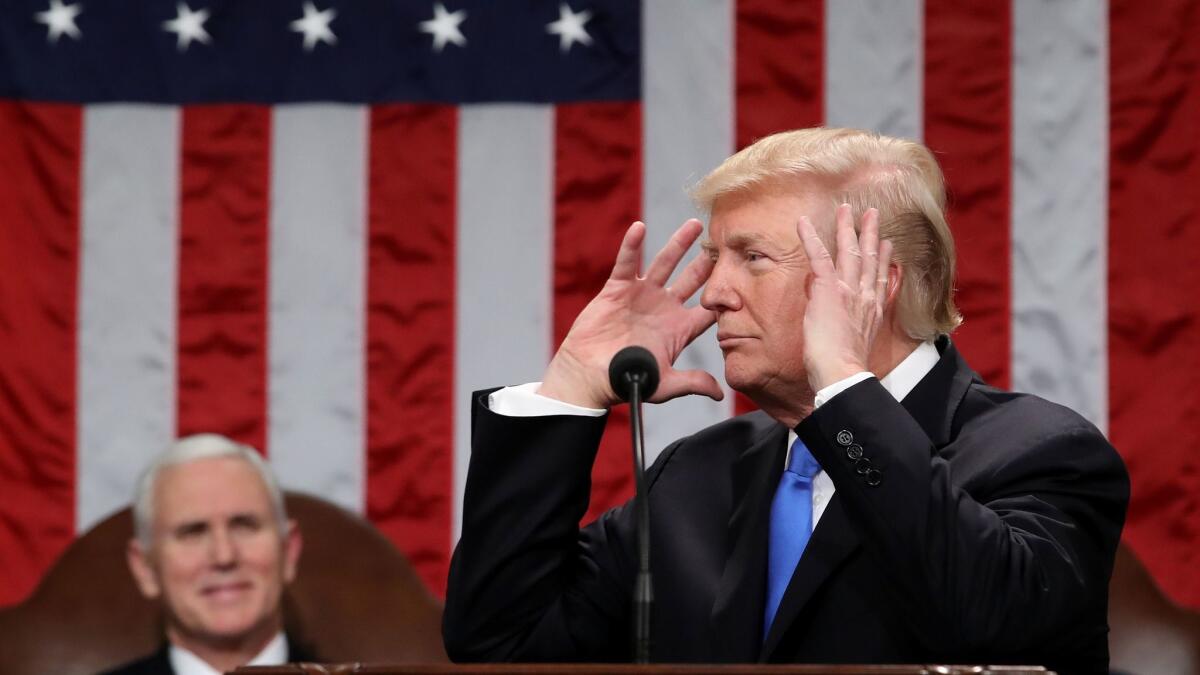Fact check: What Trump got wrong in his State of the Union address

- Share via
President Trump likes to boast about the records he has achieved, but there’s at least one mark the White House tries to downplay – the president has amassed an unprecedented number of inaccurate statements. The Times’ staff analyzed the State of the Union on Tuesday to try to separate truths from falsehoods. Here are some of the highlights:
No, the tax cuts are not the biggest in American history
The tax cuts enacted last month are not the biggest in American history, despite what Trump asserted in his speech Tuesday night.
“Just as I promised the American people from this podium 11 months ago, we enacted the biggest tax cuts and reform in American history,” Trump said.
The nonpartisan Committee for a Responsible Federal Budget estimated in October that the tax cuts as a percentage of total economic output — also known as gross domestic product — would be the 12th largest since 1918.
When adjusting for inflation, the Trump tax cuts would be the fourth largest since 1940, the group said.
Black unemployment rate is at a record low, Latino rate is close
“Something I’m very proud of, African American unemployment stands at the lowest rate ever recorded. And Hispanic American unemployment has also reached the lowest levels in history,” Trump said.
He’s right on black unemployment, but not quite right on the rate for Latinos.
The Bureau of Labor Statistics reported last month that the unemployment rate for blacks dropped to 6.8% in December, the lowest since the government began tracking the figure in 1972.
The sharp decline began eight years ago. The rate peaked in 2010 at 16.8%, which was the highest since 1984 in the aftermath of the Great Recession.
Trump has presided over a continuation of a trend in which the rate has declined about 1 percentage point a year.
The unemployment rate for Latinos, which the bureau has tracked since 1973, was 4.9% in December. The record low is 4.8%, reached in 2007 and in 2006.
Is the U.S. ‘now an exporter of energy’?
Was the president correct when he said in his speech that the U.S. is “now an exporter of energy to the world”?
No.
Trump has said this before, and exactly what he means is unclear, but nearly all the possible meanings are untrue.
The statement could mean that the U.S. has just now begun exporting energy. That’s obviously wrong — the U.S. has exported petroleum products, for example, for more than a century.
Or he could mean that the U.S. now exports more than it imports — in other words, that the U.S. now is a net exporter of energy. That may happen within the decade, but hasn’t happened yet, according to the administration’s own figures.
The Energy Department releases an annual assessment of U.S. energy production, exports and imports. In its latest assessment, the department estimates that under current trends, the U.S. would become a net exporter by 2026. Under some scenarios, that could happen earlier.
Or perhaps Trump meant that the U.S. has started exporting crude oil. That is a relatively new development, but it took place under the Obama administration.
For decades, U.S. law banned most crude oil exports. Congress repealed the ban in 2015, and Obama signed the repeal into law, although he had opposed it. Exports began two years ago — long before Trump’s election.
Trump also might have meant the U.S. is now a net exporter of natural gas. That may be true — the Energy Department had projected that U.S. exports of gas should surpass imports once the numbers from 2017 are all tallied — but, if so, that would have little to do with Trump administration policies: The trend toward greater gas exports has been building for years.
Many workers are getting tax-cut bonuses, but not thousands of dollars
“Since we passed tax cuts, roughly 3 million workers have already gotten tax cut bonuses – many of them thousands of dollars per worker,” Trump said.
The number of workers appears to be correct but most are not getting thousands of dollars apiece.
The conservative Americans for Tax Reform has kept a running list of announcements by businesses of bonuses or raises they have given to their employees because of the tax cuts.
As of Tuesday, the group said those commitments translate to at least 3 million Americans receiving “special tax reform bonuses.”
Apple is giving $2,500 bonuses in restricted stock. But few of the announced bonuses are for more than than $1,000 per employee.
So many companies are giving exactly $1,000 that some analysts have suggested the bonuses were coordinated.
In all, Americans for Tax Reform listed 285 companies that have announced bonuses or other changes to benefit workers, including wage and salary increases or larger matching funds for 401(k) retirement plans.
A USA Today analysis of companies in the Standard & Poor’s 500 index estimated that more than 1.3 million workers would receive cash or stock-based bonuses totaling at least $1.7 billion in corporate announcements that cited the tax law.
Credit Suisse estimated the tax bill would save S&P 500 companies $75 billion to $100 billion in taxes in 2018 compared with the previous year, USA Today noted.
Have workers’ wages finally gone up?
Trump said that Americans’ paychecks have at last turned the corner.
“After years and years of stagnation, we are finally seeing rising wages,” he declared.
But wage gains, in fact, have barely budged for the typical American worker.
Over the last two years, through December, the average hourly earnings for all private-sector workers have consistently risen at an annual pace of about 2.5%, according to the Bureau of Labor Statistics. Some months it’s been a little more, some a little less, but it hasn’t hit 3% since March 2009.
Now with unemployment having fallen to about 4% and employers increasingly struggling to fill jobs, many analysts do expect worker pay increases to accelerate. But so far, they are more wishes than reality.

Islamic State has lost territory, but there are still plenty of fighters
Trump said that the coalition to defeat Islamic State has liberated very close to 100% of the territory held by the militants in Iraq and Syria, and in other locations as well.
The group’s self-styled caliphate has indeed collapsed, and the number of active fighters in Iraq and Syria has plummeted. But experts warn that as many as 10,000 Islamic State loyalists could remain in the two countries.
Islamic State also retains active branches elsewhere in the Middle East, Africa and other parts of Asia — a potent threat underscored by recent deadly bombings in Afghanistan and Egypt’s restive North Sinai region.
An odd remark about ‘beautiful, clean coal’
The president said that his administration had “ended the war on beautiful, clean coal.”
It was a puzzling remark. Most of the coal plants Trump has tried to boost are hardly clean compared with other forms of energy. In fact, they create some of the most polluting power there is.
But Trump repeatedly has confused plain old coal with “clean coal.”
So-called clean coal is a marketing label for a very expensive technique to reduce pollution from coal that’s known more formally as carbon sequestration. It involves capturing the greenhouse gases generated by burning coal and storing them underground, to keep the burning of coal from accelerating climate change.
There hasn’t ever been much of a war on clean coal, although some environmental groups oppose it. The Obama administration worked aggressively to promote clean-coal plants. But the economics have yet to pencil out.
As for plain old coal, Trump’s claims that he saved the industry are dubious. It is still very much in distress.
The closures of several coal power plants have been announced since Trump took office, and most industry analysts agree the outlook for coal energy is bleak.
Environmental regulations aren’t killing coal. The market is. Other forms of energy, particularly natural gas, are cheaper, and there is little the administration can do to help the coal industry confront that existential business problem other than massive government subsidies, which so far haven’t seriously been contemplated.
To read this article in Spanish, click here
Times staff writers Don Lee, David Lauter, Jim Puzzanghera and Alexandra Zavis contributed to this report.
UPDATES:
8:40 p.m.: The story was updated with an additional fact check on “clean coal.”
This story was originally published at 7:30 p.m.
More to Read
Get the L.A. Times Politics newsletter
Deeply reported insights into legislation, politics and policy from Sacramento, Washington and beyond. In your inbox three times per week.
You may occasionally receive promotional content from the Los Angeles Times.










